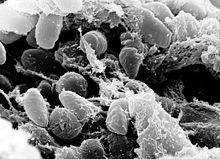| Yersinia | |
|---|---|

| |
| Scientific classification | |
| Domain: | Bacteria |
| Phylum: | Pseudomonadota |
| Class: | Gammaproteobacteria |
| Order: | Enterobacterales |
| Family: | Yersiniaceae |
| Genus: | Yersinia van Loghem, 1944 |
| Species | |
| |
Yersinia is a genus of bacteria in the family Yersiniaceae.[1] Yersinia species are Gram-negative, coccobacilli bacteria, a few micrometers long and fractions of a micrometer in diameter, and are facultative anaerobes.[2] Some members of Yersinia are pathogenic in humans; in particular, Y. pestis is the causative agent of the plague. Rodents are the natural reservoirs of Yersinia; less frequently, other mammals serve as the host. Infection may occur either through blood (in the case of Y. pestis) or in an alimentary fashion, occasionally via consumption of food products (especially vegetables, milk-derived products, and meat) contaminated with infected urine or feces.
Speculations exist as to whether or not certain Yersinia can also be spread by protozoonotic mechanisms, since Yersinia species are known to be facultative intracellular parasites; studies and discussions of the possibility of amoeba-vectored (through the cyst form of the protozoan) Yersinia propagation and proliferation are now in progress.[3]
- ^ Adeolu, Mobolaji; et al. (1 December 2016). "Genome-based phylogeny and taxonomy of the 'Enterobacteriales': proposal for Enterobacterales ord. nov. divided into the families Enterobacteriaceae, Erwiniaceae fam. nov., Pectobacteriaceae fam. nov., Yersiniaceae fam. nov., Hafniaceae fam. nov., Morganellaceae fam. nov., and Budviciaceae fam. nov". International Journal of Systematic and Evolutionary Microbiology. 66 (12): 5575–5599. doi:10.1099/ijsem.0.001485. PMID 27620848.
- ^ Ryan KJ; Ray CG, eds. (2004). Sherris Medical Microbiology (4th ed.). McGraw Hill. pp. 368–70. ISBN 0-8385-8529-9.
- ^ Bichai, F.; Payment, P.; Barbeau, B. (2008). "Protection of waterborne pathogens by higher organisms in drinking water: a review". Canadian Journal of Microbiology. 54 (7): 509–524. doi:10.1139/W08-039. PMID 18641697. S2CID 1528556.